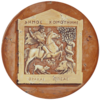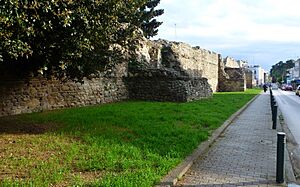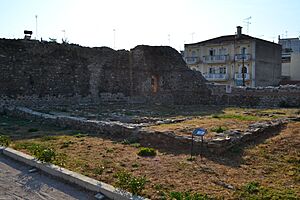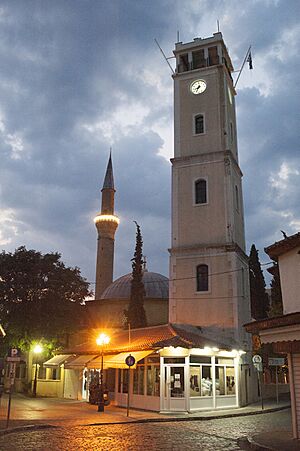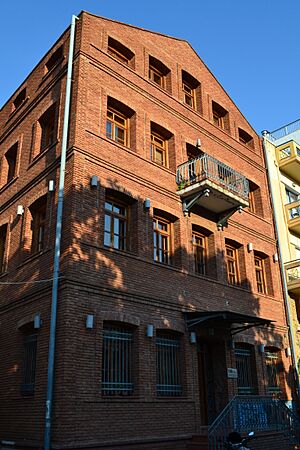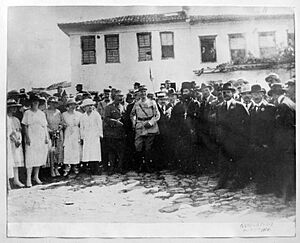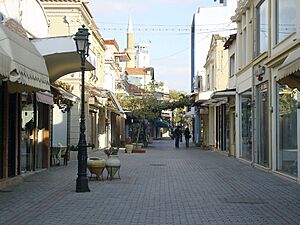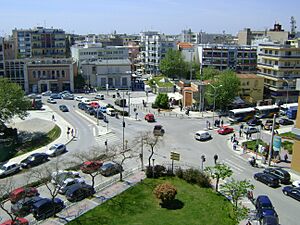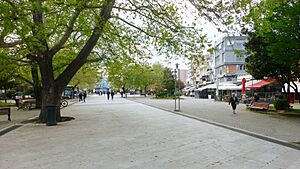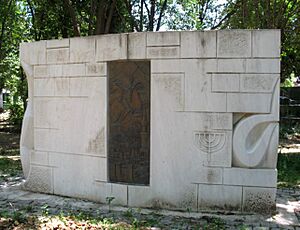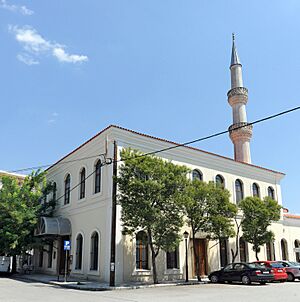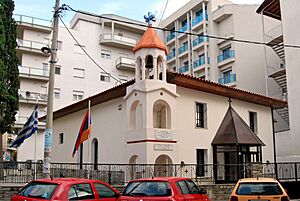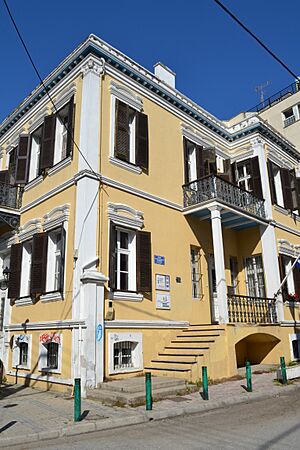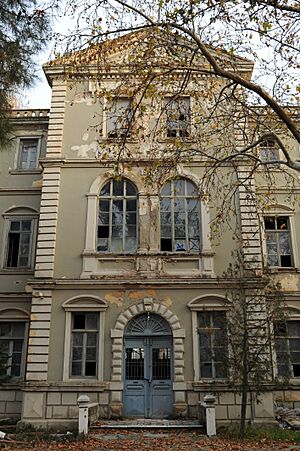Komotini facts for kids
Quick facts for kids
Komotini
Κομοτηνή
|
||
|---|---|---|
 Clockwise from top: Tsanakleion Hall which houses the Library of Komotini, Yeni Mosque Clock Tower in the Old Town of Komotini, Folklore Museum of Komotini, Downtown of Komotini, Byzantine Fortress of Komotini, Church of the Assumption of Virgin Mary.
|
||
|
||
| Country | Greece | |
| Geographic region | Thrace | |
| Administrative region | Eastern Macedonia and Thrace | |
| Regional unit | Rhodope | |
| Area | ||
| • Municipality | 644.93 km2 (249.01 sq mi) | |
| • Municipal unit | 385.4 km2 (148.8 sq mi) | |
| Elevation | 45 m (148 ft) | |
| Population
(2021)
|
||
| • Municipality | 65,243 | |
| • Municipality density | 101.1629/km2 (262.011/sq mi) | |
| • Municipal unit | 60,160 | |
| • Municipal unit density | 156.10/km2 (404.29/sq mi) | |
| Community | ||
| • Population | 54,165 (2021) | |
| Time zone | UTC+2 (EET) | |
| • Summer (DST) | UTC+3 (EEST) | |
| Postal code |
691 00
|
|
| Area code(s) | 25310 | |
| Vehicle registration | ΚΟ | |
| Website | komotini.gr | |
Komotini (Greek: Κομοτηνή, Turkish: Gümülcine) is an important city in northeastern Greece. It is the capital of the Rhodope area and a big center for administration, money, and culture. The city is also home to the Democritus University of Thrace, which opened in 1973.
Komotini has a large group of people who speak Turkish and are Muslim. These people were not part of the big population exchange between Greece and Turkey in 1923. In 2021, about 65,243 people lived in Komotini. The city is a key place for travel, located far from Athens and Thessaloniki. Many students, both Greek and international, live here because of the university. This mix of cultures makes Komotini an interesting place to visit.
Contents
Komotini Through the Ages
Komotini has a long and interesting past. It has been a settlement for almost 2,000 years!
Ancient Times
Komotini started as a small settlement around the 2nd century AD. We know this from old items found there. An old wall from the 4th century has an inscription that says "Building of Theodosius." This means the Roman Emperor Theodosius I built a fortress here.
During the Roman period, Komotini was one of many forts along the Via Egnatia. This was a very important Roman road that connected different parts of the empire. Komotini was a stop on this road, especially for routes going north into the mountains.
Byzantine Era
The city's story is closely tied to the Via Egnatia road. Emperor Theodosius I built a small, strong fort here. For a long time, Komotini was smaller than a nearby town called Mosynopolis. By the end of the 12th century, Komotini was almost empty.
But in 1207, something changed. The Bulgarian tsar Kaloyan destroyed Mosynopolis. People from Mosynopolis moved to Komotini and rebuilt it inside the old fort walls. From then on, Komotini grew steadily. In the 1300s, it was mentioned in historical writings as "Koumoutzina." It became an important town in the area.
Ottoman Era
The Ottoman Empire took over Komotini between 1361 and 1363. The city was then called Gümülcine in Turkish. This name is still used today. Komotini continued to be a key city, connecting the Ottoman capital, Constantinople, with other parts of the empire. Many old buildings in the city today are from this time.
The Ottomans brought Turkish settlers to the area. Over time, Muslim Turks became the main group in the villages around Komotini. A leader named Gazi Evrenos Bey built a small mosque, a public kitchen (imaret), baths, and shops. These buildings helped create a strong Islamic community in the area.
In the 1500s, Komotini had about 2,500 people. Most were Muslim, but there were also Christians and Jewish families. Later, in the 1600s, more buildings were added, like the Yeni Mosque. This mosque is special because it has beautiful tiles from the 1580s.
Komotini faced challenges like sickness, but it grew again in the 1800s. During the Greek War of Independence, people from Komotini helped fight for freedom. The city also became rich from growing and selling tobacco. Sultan Abdulhamid II built a clock tower and a school. A railway line connecting Constantinople to Salonica also passed through Komotini, helping it grow even more.
Balkan Wars and World War I
During the First Balkan War, Bulgarian forces took over Komotini. But then, the Greek army captured it in July 1913 during the Second Balkan War. For a short time, Komotini was the capital of a new government called the Provisional Government of Western Thrace. However, the Treaty of Bucharest gave the city back to Bulgaria.
Komotini remained part of Bulgaria until the end of World War I. After the war, in 1919, the Treaty of Neuilly gave Komotini and the rest of Western Thrace to Greece.
People of Komotini
Komotini is a city with many different cultures and languages. Its people include local Greeks, Greek refugees who came from Asia Minor and East Thrace, and a large Muslim population. This Muslim group includes people of Turkish, Pomak, Greek, and Roma backgrounds.
There are also descendants of refugees from the Armenian genocide and Pontic Greeks from other countries. The Muslim population in Western Thrace has been there since the Ottoman times. They were allowed to stay in Greece after the 1922-23 population exchange. Komotini has one of the highest percentages of Muslims in any city in the European Union.
Komotini Today
Today, Komotini is a busy city for business and government. Most shops and services are in the old part of the city, making it easy to walk around. A river used to flow through the city, but it was moved in the 1970s to prevent floods. Now, its old path is used for main roads.
Heart of the City
In the center of Komotini, you'll find the green Municipal Central Park and a tall memorial called 'The Sword'. The main square, Plateia Irinis (Peace Square), is a lively place, especially at night, thanks to all the students. The old market area is popular with visitors. It has traditional shops that are hard to find in other Greek cities.
Outside the city center, there's a modern shopping area called Kosmopolis Park. It has big stores, supermarkets, a cinema, cafes, and restaurants. This area is becoming a popular spot for shopping.
Culture and Fun
Komotini has several museums, including the Archaeological, Byzantine, and Folklore museums. These museums show the city's rich history and culture. Near the main square, there's an outdoor theater where many cultural shows take place, especially in summer. There's also a local theater group that puts on plays all year.
About 6 kilometers (3.7 miles) northeast of Komotini is the Nymfaia forest. It's a great place for outdoor activities like walking on trails and playing sports. There are also ruins of another Byzantine fortress and a historical fort from World War II in the forest.
Jewish Community
Jewish people have lived in the Komotini area for a very long time. In the 1500s, many Jewish families, called Sephardic Jews, lived here. They were often involved in selling textiles and wool. The Jewish community grew, and they built a synagogue called Beth El in the 1800s.
During World War II, when the Bulgarians were in charge (who were allies of the Nazis), many Jewish people from Komotini were arrested. They were sent to a terrible camp called Treblinka, where most of them died. Only 28 survived. After the war, the Jewish community in Komotini became very small and eventually closed down. In 2004, the city built a memorial in the Central Park to remember the victims of the Holocaust.
Geography and Climate
Komotini is located on the Thracian plain, close to the Rhodope Mountains. The city is between two rivers, the Boklutzas and the Trelohimaros. The older parts of the city have narrow, winding streets, while newer areas are more planned out.
In 2011, the city had about 66,919 people, not including the many students and soldiers who live there. There are two airports nearby: one in Alexandroupoli (65 km away) and another in Kavala (80 km away). Komotini also has train and bus connections to other Greek cities and even Istanbul. A new highway, the Egnatia Odos, makes travel even easier.
| Climate data for Komotini, Greece | |||||||||||||
|---|---|---|---|---|---|---|---|---|---|---|---|---|---|
| Month | Jan | Feb | Mar | Apr | May | Jun | Jul | Aug | Sep | Oct | Nov | Dec | Year |
| Mean daily maximum °F (°C) | 48 (9) |
50 (10) |
55 (13) |
64 (18) |
73 (23) |
82 (28) |
88 (31) |
88 (31) |
79 (26) |
69 (21) |
58 (14) |
50 (10) |
67 (19) |
| Mean daily minimum °F (°C) | 33 (1) |
34 (1) |
38 (3) |
45 (7) |
53 (12) |
61 (16) |
65 (18) |
65 (18) |
58 (14) |
51 (11) |
42 (6) |
36 (2) |
48.416 (9.12) |
| Source: <World Weather Online= > | |||||||||||||
City Organization
The city of Komotini was formed in 2011 by joining three smaller areas: Aigeiros, Komotini, and Neo Sidirochori. The total area of the municipality is about 644.934 square kilometers.
Parts of the City
Komotini is divided into several areas:
- Central: This is the old business center.
- West: Includes areas like Nea Mosinoupoli and Remvi.
- South-West: Areas like Kavakliotika and Stathmos.
- South: The Zimvrakaki area.
- South-East: Agios Stylianos.
- East: Neoktista.
- North: Agia Varvara/Stratones.
Nearby Areas
Around Komotini, there are several important suburbs and areas:
- Komotini Industrial Zone: Located southeast of the city, it has many factories.
- Panepistimioupoli/Democritus University Campus: Northwest of the city, this is where the university is located.
- Ifaistos: Next to Nea Mosinoupoli, home to a large Roma community.
- Roditis and Karidia: Residential areas with nice homes.
- Kosmio, Thrilorio, Ampelokipoi, Kikidio, Ifantes: Other mixed residential and business areas.
Education in Komotini
Komotini has many schools for all ages. There are about 20 primary schools, 7 junior high schools (gymnasia), and 4 high schools (lykeia). There are also vocational training institutes.
Komotini is known as a university city in Northern Greece. It is home to the main offices and many departments of the Democritus University of Thrace. This university has about 5,000 to 10,000 students. The university has helped the city grow a lot since it was founded in 1973.
Some of the university departments include:
- Law School
- Physical Education and Sport Sciences
- History and Ethnology
- Greek Literature
- Social Administration
- International Financial Relations and Development
- Business Management
- Politics
- Languages, Literature and Civilization of Black Sea countries
The Police Academy is also located near Komotini, about 7 kilometers (4.3 miles) away.
Media in Komotini
Komotini has its own television and radio stations, as well as several newspapers.
Television
The main TV station in Komotini is R Channel. Other stations also broadcast from nearby cities.
Radio
Some of the main radio stations in Komotini are:
- ERA Komotinis
- Radio Paratiritis
- Diavlos Rodopis
- Hit FM
- Joy FM
- Radio Komotini
- Isik FM
- Radio City
Press
Komotini has several daily and weekly newspapers, including:
- Paratiritis tis Thrakis (Observer of Thrace)
- To Elefthero Vima (Free Standpoint)
- Thrakiki Agora (Thracian Market)
- I Paremvasi (Intervention)
- I Foni tis Rodopis (Voice of Rodopi)
- Antifonitis (The Opposition)
- Thrakiki Gi (Thracian Land)
- I Patrida (The Homeland)
Many of these newspapers also have websites where you can read the news.
Getting Around Komotini
Komotini is inland, so it doesn't have a port. But it's easy to get to by road, train, and air.
Roads
The European route E90 goes through Komotini, connecting it to other Greek cities. The new Egnatia Odos highway also passes south of the city. You can enter Komotini from two main exits: 'Komotini West' and 'Komotini East'.
Public Transport
Komotini has local buses that serve three main routes within the city. There's also an Intercity Bus Company that connects Komotini to nearby villages, coastal areas, and major Greek cities.
Railway
The city has a train station. Trains run regularly to Thessaloniki and Athens in the west, and to Evros and sometimes Istanbul in the east. The station is located outside the city center.
Sports in Komotini
Komotini has many great sports facilities. These include the Komotini Municipal Stadium (home of Panthrakikos FC), a training ground, a municipal sports complex, a swimming pool, and a basketball arena. The Democritus University also has its own sports complex. The mountains north of the city are perfect for mountain biking, hiking, and 4x4 racing.
| Sport clubs based in Komotini | |||
|---|---|---|---|
| Club | Founded | Sports | Achievements |
| AE Komotinis | 1936 | Football, Volleyball | Played in Greece's top volleyball league before |
| Panthrakikos F.C. | 1963 | Football | Played in Greece's top football league before |
| GAS Komotinis | 1976 | Basketball | Played in Greece's second-tier basketball league before |
Population Changes
| Year | Town population | Municipality population |
|---|---|---|
| 1981 | 34,051 | 37,487 |
| 1991 | 37,036 | 39,927 |
| 2001 | 43,326 | 52,659 |
| 2011 | 50,990 | 66,919 |
| 2021 | 51,732 | 65,243 |
Famous People from Komotini
- Sadik Achmet (1947 - 1995), a politician who worked for the rights of the Turkish minority.
- Konstantinos Baniotis (born 1986), a high jumper.
- Archbishop Chrysanthus of Athens (1881 - 1949), a religious leader.
- Frangoulis Frangos (born 1951), a general and former Minister for National Defence.
- Apostolos Grozos (1892 - 1981), a politician and leader of the Communist Party of Greece.
- Hamza Hamzaoglou (born 1970), a Turkish football player.
- Nikolaos Kaltsas, an archaeologist and former director of the National Archaeological Museum, Athens.
- Stilpon Kyriakidis (1887 - 1964), a professor of history and folklore.
- Petros Mantalos (born 1991), a Greek football player.
- Nasuh Pasha (died 1614), a Grand Vizier of the Ottoman Empire (a very high-ranking official).
- George Petalotis (born 1964), a Greek politician.
- Paul Soulikias (1926 – 2023), a Greek-Canadian painter.
- Evripidis Stylianidis (born 1966), a Greek politician and former Minister of the Interior.
Images for kids
See also
 In Spanish: Komotiní para niños
In Spanish: Komotiní para niños


